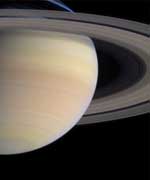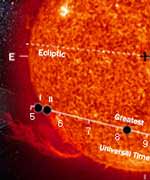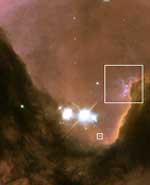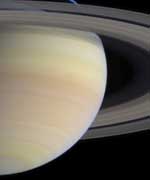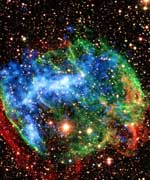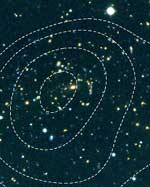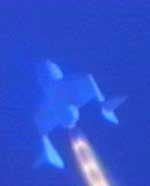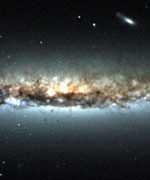
Image credit: NOAO
New observations from the WIYN 3.5-meter telescope on Kitt Peak show striking visual evidence for a galaxy being stripped bare of its star-forming material by its violent ongoing encounter with the hot gas in the center of a galaxy cluster.
This extremely disruptive process is believed to be a major influence on the evolution of galaxies and their star-forming ability over time, but direct observational evidence has been more circumstantial than incontrovertible.
A new three-color composite image of spiral galaxy NGC 4402, taken as the galaxy falls into the Virgo galaxy cluster, shows several key lines of evidence of an ongoing interaction, according to a presentation today in Denver at the 204th meeting of the American Astronomical Society.
NGC 4402 is located more than 50 million light years from Earth, in the midst of the relatively nearby Virgo cluster. As the galaxy moves toward the center of the cluster (located out of the image toward the bottom left), it experiences a ?wind? from the hot cluster gas, which can reach temperatures of millions of degrees.
?This hot wind strips out the much cooler gas and dust in the galaxy. This is important because the gas is raw material for new stars, and once this gas is stripped, the galaxy can no longer form new stars and becomes ?dead? in a sense,? says Hugh Crowl of Yale University, New Haven, CT, lead author of the paper. ?We see at least four distinct lines of evidence for declaring that this ram-pressure stripping process is cleaning out this infalling spiral galaxy.?
* First, the dust disk appears to be truncated, meaning that the light from stars extends out well beyond where gas and dust is observed. ?Since we believe that stars are born in clouds of gas and dust, this suggests that some of the material must have been stripped from the galaxy after the stars were born,? Crowl explains.
* Second, the dusty disk appears to be ?bowed? upward; that is, it has been bent by the wind blowing from the southeast (from the lower left of the image).
* Third, it appears that the light emitted by the north side of the stellar disk has been reddened and dimmed by dust that has been pushed up in front of it by the pressure of the cluster gas. Simultaneously, the dust to the south of the disk has been removed, revealing young blue stars glowing behind it.
* Finally, some of the most unusual features of NGC 4402 are the linear filaments of dust to the south of its main disk. ?These remarkable filaments originate in clumps that appear to be the densest remnants of the now displaced disk of the galaxy,? Crowl says.
The filaments are being ?ablated,? or stripped away, in an outside-in fashion, similar to the process observed in much smaller filamentary features in hot star-forming nebula such as the Eagle Nebula and Pelican Nebula. The hot galaxy cluster wind strips away the outer layers of the cloud, and the dust from these layers is then pushed away. In one case (the eastern or leftmost filament), ?we can see that the wind has either triggered star formation toward the tip of one of these dense clumps or exposed an already-existing star forming region,? Crowl adds.
The bright blue clusters of young stars in the bottom left region of the galaxy?s disk is further evidence of recently triggered star formation.
?This image clearly shows galactic disruption on a grand scale,? Crowl adds. ?It gives us much more confidence that this widely postulated process truly plays a significant role in shaping the evolution of galaxies in clusters.?
This imaging data was obtained with the help of the WIYN Tip-Tilt module, an adaptive optics device that uses a movable mirror to provide first-order compensation for the jittery motion of the incoming image caused by variable atmospheric conditions and telescope vibrations.
This result will be presented in poster 80.12 at the AAS meeting, located in the Ballroom poster session from 9:20 a.m. to 4:00 p.m. Co-authors of the paper are Jeff Kenney (Yale), J.H. van Gorkom (Columbia University), and B. Vollmer (CDS, Strasbourg).
The Wisconsin-Indiana-Yale-NOAO (WIYN) 3.5-meter telescope is located at Kitt Peak National Observatory, 55 miles southwest of Tucson, AZ. Kitt Peak National Observatory is part of the National Optical Astronomy Observatory, which is operated by the Association of Universities for Research in Astronomy (AURA), Inc., under a cooperative agreement with the National Science Foundation (NSF).
Original Source: NOAO News Release

